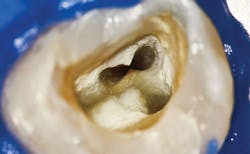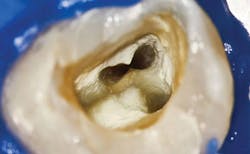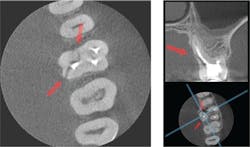Lessons from endodontics: Advantages of adopting new imaging technologies
Diwakar Kinra, DDS, MS
New dental technologies are constantly being developed, and clinicians must decide which innovations best fit their individual needs. I pride myself on being on the “leading” edge of technology, but not the “bleeding” edge. This means I implement products that are supported by scientific research and proven to be clinically viable. In this article, I am going to share products and technologies that have helped distinguish my practice, particularly in regard to visualization.
As an endodontic specialist, I feel the need to go above and beyond to provide quality treatment. In many respects, patients also have higher expectations of me as an endodontist. By adopting advancements in the following three areas of technology, our practice has improved the quality of treatment and met patient expectations:
- Magnification and illumination
- 2-D digital imaging
- 3-D imaging/cone beam computed tomography (CBCT)
Magnification and illumination
A good microscope with powerful illumination is imperative technology for endodontists (figure 1). It has been shown repeatedly in the research that the dental operating microscope allows practitioners to locate anatomy at a far greater success rate compared to the unaided eye. This allows one to be minimally invasive during root canal procedures. This benefits the referring dentist, who is left with more tooth structure for the restoration.
When microscopy was introduced in the 1990s, clinicians were resistant to use it. They challenged whether the expense was justified and whether outcomes would be better. Now, microscopy has evolved to be one of our standards of care that few specialists will work without. I personally rely on a dental microscope from Global Surgical Corporation.
Imaging
The same concept is true with other types of technology. Dental practices have evolved from using traditional film to 2-D digital radiography and 3-D CBCT. With each advancement, the view of the anatomy becomes appreciably more detailed.
Because endodontics necessitates capturing a fair number of radiographs, endodontists appreciate 2-D digital imaging because it requires a lower amount of radiation than traditional film radiography. Such is the case with my DEXIS system (figure 2). Studies have shown that capturing one view of a tooth garners only a limited percentage of information, but both a straight-on view and an angled view results in a greater amount of details. Also, in a digital format, quick access to the data results in more efficient use of time.
During endodontic treatment, I may need a “check” radiograph to see if I am in the proper length for a root canal, or if I am in the proper orientation for access. My digital system allows me to quickly capture an image. For these check radiographs, DEXIS provides sensor holders in the shape of paddles that allow the rubber dam to stay on while capturing an image and not violating sterilization protocol.
I like the software features of the DEXIS Imaging Suite. My Soredex 3-D CBCT imaging is stored in the DEXIS software. When I view the patient’s imaging in DEXIS, I can switch between 2-D and 3-D images. In other words, I don’t have to open up different software. This type of workflow ease is essential in streamlining the patient experience.
3-D technology allows for thorough treatment planning (figure 3). While I do not take a 3-D scan on every patient, 3-D images are captured when we feel the benefit outweighs the risk to the patient. Some examples of this are a failing root canal, a presurgical consultation to determine an odontogenic or nonodontogenic lesion, or if the source of the patient’s chief complaint is not obvious on the 2-D radiograph. Some other uses for CBCT are when I sense complicated anatomy, resorption, perforations, or instrument failures.
The 3-D imaging software also allows me to take measurements that I use in conjunction with my microscope to locate difficult anatomy in a conservative manner. Also, I can be more cautious when using a CBCT during treatment planning. The technology helps me confirm when not to treat certain “hopeless” teeth. Before implementing 3-D imaging, I would have had to open up the tooth or perform an irreversible procedure, only to discover that the tooth could not be saved.
It is interesting to note that when looking at a preoperative image with CBCT, 62% of clinicians change their treatment plans because they receive more information.1 Dental treatment changes when one has the full knowledge to create a more thorough treatment plan.
Our patients benefit from seeing their images. I have a monitor on the footrest of the patient’s chair that I use to show both 2-D and 3-D images. When patients see their images in conjunction with my explanation, they understand the problem and why they need a certain procedure. Case acceptance goes up tremendously when patients are actively involved in their own health care.
Here is some advice before adding 3-D technology to your office. Learning to use a CBCT is not difficult, but check to make sure that proper training is incorporated into the cost of the machine. Look for a company that has a good track record when it comes to service and stands behind the product it sells. There is a learning curve, so stick with it and get help from mentors when needed. Also, choose a brand within ALARA (as low as reasonably achievable) radiation standards. If you are uncomfortable with reading CBCT images or suspect an anomaly, send the scan to an oral radiologist.
Endodontists are notorious for being early adopters of technology. I can’t believe that it has been 12 years since I began using 2-D digital radiography. As with my other technologies, my investments continue to pay back over the years in better diagnostics and more efficient treatment methods. When patients see these high-quality imaging methods and realize their endodontist is investing in better patient care, the reputation boost contributes to your monetary return.
Reference
1. Ee J, Fayad MI, Johnson BR. Comparison of endodontic diagnosis and treatment planning decisions using cone-beam volumetric tomography versus periapical radiography. J Endod. 2014;40(7):910-916.
Diwakar Kinra, DDS, MS, received his dental degree in 1999 from the University of Michigan and his master’s degree in endodontics from the University of Detroit-Mercy in 2004. Afterward, he began his solo private practice limited to endodontics in Flint, Michigan. Dr. Kinra is an adjunct professor at the University of Detroit-Mercy Department of Endodontics and Periodontics. He lectures extensively on practice management and endodontics.



